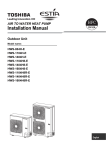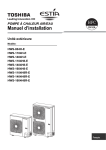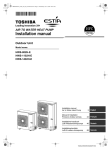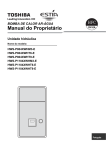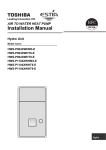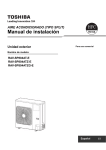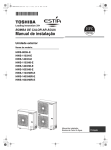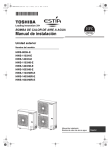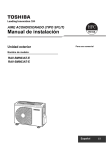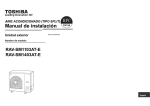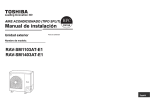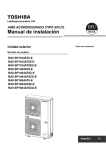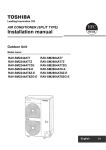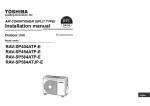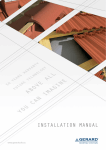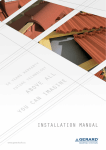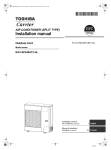Download Installation Manual
Transcript
AIR TO WATER HEAT PUMP
Installation Manual
Outdoor Unit
Model name:
HWS-P804HR-E
HWS-P1104HR-E
English
Installation Manual
Air to Water Heat Pump
Please read this Installation Manual carefully before installing the Air to Water Heat Pump.
• This Manual describes the installation method of the outdoor unit.
• For installation of the hydro unit, follow the Installation Manual attached to the hydro unit.
Original instruction
REFRIGERANT
This Air to Water Heat Pump uses an HFC refrigerant (R410A) in order to prevent destruction of the ozone
layer.
▼ HWS-P804HR-E, HWS-P1104HR-E
Equipment complying with IEC 610003-12.
1-EN
–1–
Installation Manual
Air to Water Heat Pump
Contents
1 Precautions for safety . . . . . . . . . . . . . . . . . . . . . . . . . . . . . . . . . . . . . . . . . . . . . . . . . . 5
2 Accessory parts and refrigerant . . . . . . . . . . . . . . . . . . . . . . . . . . . . . . . . . . . . . . . . . 7
3 Installation of new refrigerant air to water heat pump . . . . . . . . . . . . . . . . . . . . . . . . 8
4 Installation conditions. . . . . . . . . . . . . . . . . . . . . . . . . . . . . . . . . . . . . . . . . . . . . . . . . . 9
5 Refrigerant piping . . . . . . . . . . . . . . . . . . . . . . . . . . . . . . . . . . . . . . . . . . . . . . . . . . . . 13
6 Air purging . . . . . . . . . . . . . . . . . . . . . . . . . . . . . . . . . . . . . . . . . . . . . . . . . . . . . . . . . . 16
7 Electrical work . . . . . . . . . . . . . . . . . . . . . . . . . . . . . . . . . . . . . . . . . . . . . . . . . . . . . . . 18
8 Earthing . . . . . . . . . . . . . . . . . . . . . . . . . . . . . . . . . . . . . . . . . . . . . . . . . . . . . . . . . . . . 21
9 Finishing. . . . . . . . . . . . . . . . . . . . . . . . . . . . . . . . . . . . . . . . . . . . . . . . . . . . . . . . . . . . 21
10 Test run. . . . . . . . . . . . . . . . . . . . . . . . . . . . . . . . . . . . . . . . . . . . . . . . . . . . . . . . . . . . . 21
11 Annual maintenance . . . . . . . . . . . . . . . . . . . . . . . . . . . . . . . . . . . . . . . . . . . . . . . . . . 21
12 Air to water heat pump operating conditions . . . . . . . . . . . . . . . . . . . . . . . . . . . . . . 21
13 Functions to be implemented locally. . . . . . . . . . . . . . . . . . . . . . . . . . . . . . . . . . . . . 22
14 Troubleshooting . . . . . . . . . . . . . . . . . . . . . . . . . . . . . . . . . . . . . . . . . . . . . . . . . . . . . 23
15 Appendix . . . . . . . . . . . . . . . . . . . . . . . . . . . . . . . . . . . . . . . . . . . . . . . . . . . . . . . . . . . 25
–2–
2-EN
Installation Manual
Air to Water Heat Pump
Generic denomination: air to water heat pump
Definition of qualified installer or qualified service person
The air to water heat pump must be installed, maintained, repaired and removed by a qualified installer or qualified
service person. When any of these jobs is to be done, ask a qualified installer or qualified service person to do them
for you.
A qualified installer or qualified service person is an agent who has the qualifications and knowledge described in
the table below.
Agent
Qualifications and knowledge which the agent must have
• The qualified installer is a person who installs, maintains, relocates and removes the air to water heat
pumps made by Toshiba Carrier Corporation. He or she has been trained to install, maintain, relocate
and remove the air to water heat pump made by Toshiba Carrier Corporation or, alternatively, he or she
has been instructed in such operations by an individual or individuals who have been trained and is thus
thoroughly acquainted with the knowledge related to these operations.
• The qualified installer who is allowed to do the electrical work involved in installation, relocation and
removal has the qualifications pertaining to this electrical work as stipulated by the local laws and
regulations, and he or she is a person who has been trained in matters relating to electrical work on the
air to water heat pump made by Toshiba Carrier Corporation or, alternatively, he or she has been
instructed in such matters by an individual or individuals who have been trained and is thus thoroughly
acquainted with the knowledge related to this work.
Qualified installer
• The qualified installer who is allowed to do the refrigerant handling and piping work involved in installation,
relocation and removal has the qualifications pertaining to this refrigerant handling and piping work as
stipulated by the local laws and regulations, and he or she is a person who has been trained in matters
relating to refrigerant handling and piping work on the air to water heat pump made by Toshiba Carrier
Corporation or, alternatively, he or she has been instructed in such matters by an individual or individuals
who have been trained and is thus thoroughly acquainted with the knowledge related to this work.
• The qualified installer who is allowed to work at heights has been trained in matters relating to working at
heights with the air to water heat pump made by Toshiba Carrier Corporation or, alternatively, he or she
has been instructed in such matters by an individual or individuals who have been trained and is thus
thoroughly acquainted with the knowledge related to this work.
Qualified service
person
3-EN
• The qualified service person is a person who installs, repairs, maintains, relocates and removes the air
to water heat pump made by Toshiba Carrier Corporation. He or she has been trained to install, repair,
maintain, relocate and remove the air to water heat pump made by Toshiba Carrier Corporation or,
alternatively, he or she has been instructed in such operations by an individual or individuals who have
been trained and is thus thoroughly acquainted with the knowledge related to these operations.
• The qualified service person who is allowed to do the electrical work involved in installation, repair,
relocation and removal has the qualifications pertaining to this electrical work as stipulated by the local
laws and regulations, and he or she is a person who has been trained in matters relating to electrical work
on the air to water heat pump made by Toshiba Carrier Corporation or, alternatively, he or she has been
instructed in such matters by an individual or individuals who have been trained and is thus thoroughly
acquainted with the knowledge related to this work.
• The qualified service person who is allowed to do the refrigerant handling and piping work involved in
installation, repair, relocation and removal has the qualifications pertaining to this refrigerant handling and
piping work as stipulated by the local laws and regulations, and he or she is a person who has been
trained in matters relating to refrigerant handling and piping work on the air to water heat pump made by
Toshiba Carrier Corporation or, alternatively, he or she has been instructed in such matters by an
individual or individuals who have been trained and is thus thoroughly acquainted with the knowledge
related to this work.
• The qualified service person who is allowed to work at heights has been trained in matters relating to
working at heights with the air to water heat pump made by Toshiba Carrier Corporation or, alternatively,
he or she has been instructed in such matters by an individual or individuals who have been trained and
is thus thoroughly acquainted with the knowledge related to this work.
–3–
Installation Manual
Air to Water Heat Pump
Definition of protective gear
When the air to water heat pump is to be transported, installed, maintained, repaired or removed, wear protective
gloves and “safety” work clothing.
In addition to such normal protective gear, wear the protective gear described below when undertaking the special
work detailed in the table below.
Failure to wear the proper protective gear is dangerous because you will be more susceptible to injury, burns,
electric shocks and other injuries.
Work undertaken
Protective gear worn
All types of work
Protective gloves
“Safety” working clothing
Electrical-related work
Gloves to provide protection for electricians and from heat
Insulating shoes
Clothing to provide protection from electric shock
Work done at heights (50 cm or Helmets for use in industry
more)
Transportation of heavy objects Shoes with additional protective toe cap
Repair of outdoor unit
Gloves to provide protection for electricians and from heat
Warning Indications on the Air to water heat pump Unit
Warning indication
WARNING
ELECTRICAL SHOCK HAZARD
Disconnect all remote
electric power supplies
before servicing.
WARNING
Moving parts.
Do not operate unit with grille
removed.
Stop the unit before the servicing.
CAUTION
High temperature parts.
You might get burned
when removing this panel.
CAUTION
Do not touch the aluminum
fins of the unit.
Doing so may result in injury.
CAUTION
BURST HAZARD
Open the service valves before
the operation, otherwise there
might be the burst.
Description
WARNING
ELECTRICAL SHOCK HAZARD
Disconnect all remote electric power supplies before servicing.
WARNING
Moving parts.
Do not operate unit with grille removed.
Stop the unit before the servicing.
CAUTION
High temperature parts.
You might get burned when removing this panel.
CAUTION
Do not touch the aluminum fins of the unit.
Doing so may result in injury.
CAUTION
BURST HAZARD
Open the service valves before the operation, otherwise there might be the
burst.
–4–
4-EN
Installation Manual
Air to Water Heat Pump
1
Precautions for safety
• Ensure that all Local, National and International regulations are satisfied.
• Read this “Precautions for safety” carefully before Installation.
• The precautions described below include the important items regarding safety.
Observe them without fail.
• After the installation work, perform a test run to check for any problem.
Follow the Owner’s Manual to explain how to use and maintain the unit to the customer.
• Turn off the main power supply switch (or breaker) before the unit maintenance.
• Ask the customer to keep the Installation Manual together with the Owner’s Manual.
WARNING
• Ask an authorized dealer or qualified installation professional to install / maintain the Air to Water Heat Pump.
Inappropriate installation may result in water leakage, electric shock or fire.
• Be sure to connect earth wire. (grounding work)
Incomplete grounding cause an electric shock.
Do not connect ground wires to gas pipes, water pipes, lightning rods or ground wires for telephone wires.
• Turn off the main power supply switch or breaker before attempting any electrical work.
Make sure all power switches are off. Failure to do so may cause electric shock.
Use an exclusive power circuit for the Air to Water Heat Pump. Use the rated voltage.
• Connect the system interconnection wire correctly.
If the system interconnection wire is connected in a wrong way, electric parts may be damaged.
• When moving the Air to Water Heat Pump for the installation into another place, be very careful not to enter
any gaseous matter other than the specified refrigerant into the refrigeration cycle.
If air or any other gas is mixed in the refrigerant, the gas pressure in the refrigeration cycle becomes abnormally high
and it may resultingly causes pipe burst and injuries on persons.
• Do not modify this unit by removing any of the safety guards or by by-passing any of the safety interlock
switches.
• After unpacking the unit, examine it carefully if there are possible damage.
• Do not install in a place that might increase the vibration of the unit.
• To avoid personal injury (with sharp edges), be careful when handling parts.
• Perform installation work properly according to the Installation Manual.
Inappropriate installation may result in water leakage, electric shock or fire.
• When the Air to Water Heat Pump hydro unit is installed in a small room, provide appropriate measures to
ensure that the concentration of refrigerant leakage occur in the room does not exceed the critical level.
• Tighten the flare nut with a torque wrench in the specified manner.
Excessive tightening of the flare nut may cause a crack in the flare nut after a long period, which may result in
refrigerant leakage.
• Wear heavy gloves during the installation work to avoid injury.
• Install the Air to Water Heat Pump securely in a location where the base can sustain the weight adequately.
• Perform the specified installation work to guard against an earthquake.
If the Air to Water Heat Pump is not installed appropriately, accidents may occur due to the falling unit.
• If refrigerant gas has leaked during the installation work, ventilate the room immediately.
If the leaked refrigerant gas comes in contact with fire, noxious gas may generate.
• After the installation work, confirm that refrigerant gas does not leak.
If refrigerant gas leaks into the room and flows near a fire source, such as a cooking range, noxious gas might
generate.
• Electrical work must be performed by a qualified electrician in accordance with the Installation Manual.
Make sure the Air to Water Heat Pump uses a dedicated power supply.
An insufficient power supply capacity or inappropriate installation may cause fire.
• Use the specified wires for wiring connect the terminals securely fix.
To prevent external forces applied to the terminals from affecting the terminals.
5-EN
–5–
Installation Manual
Air to Water Heat Pump
• When the Air to Water Heat Pump cannot cool or heat water well, contact the dealer from whom you
purchased the Air to Water Heat Pump as refrigerant leakage is considered as the cause.
In the case of repair that requires refill of refrigerant, ask service personnel about details of the repair.
The refrigerant used in the Air to Water Heat Pump is harmless.
Generally, the refrigerant does not leak. However, if the refrigerant leaks in a room and a heater or stove burner in
the room catches fire, it may generate toxic gas.
When you ask service personnel for repairing refrigerant leakage, confirm that the leakage portion has been
completely repaired.
• Conform to the regulations of the local electric company when wiring the power supply.
Inappropriate grounding may cause electric shock.
• Do not install the Air to Water Heat Pump in a location subject to a risk of exposure to a combustible gas.
If a combustible gas leaks, and stays around the unit, a fire may occur.
• Install the refrigerant pipe securely during the installation work before operating the Air to Water Heat Pump.
If the compressor is operated with the valve open and without the refrigerant pipe, the compressor sucks air and the
refrigeration cycle is overpressurized, which may cause a burst or injury.
• For the refrigerant recovery work (collection of refrigerant from the pipe to the compressor), stop the
compressor before disconnecting the refrigerant pipe.
If the refrigerant pipe is disconnected while the compressor is working with the valve open, the compressor sucks air
and the refrigeration cycle is overpressurized, which may cause a burst or injury.
CAUTION
New refrigerant air to water heat pump installation
• This air to water heat pump adopts the new HFC refrigerant (R410A) which does not destroy ozone layer.
• The characteristics of R410A refrigerant are; easy to absorb water, oxidizing membrane or oil, and its pressure is
approx. 1.6 times higher than that of refrigerant R22. Accompanied with the new refrigerant, refrigerating oil has also
been changed. Therefore, during installation work, be sure that water, dust, former refrigerant, or refrigerating oil does
not enter the refrigerating cycle.
• To prevent charging an incorrect refrigerant and refrigerating oil, the sizes of connecting sections of charging port of
the main unit and installation tools are changed from those for the conventional refrigerant.
• Accordingly the exclusive tools are required for the new refrigerant (R410A).
• For connecting pipes, use new and clean piping designed for R410A, and please care so that water or dust does not
enter.
To disconnect the appliance from main power supply
• This appliance must be connected to the main power supply by means of a switch with a contact separation of at
least 3 mm.
• The installation fuse must be used for the power supply line of this unit.
–6–
6-EN
Installation Manual
Air to Water Heat Pump
2
Accessory parts and refrigerant
Accessory parts
Part name
7-EN
Qty
Shape
Usage
Hand this directly to the customer.
(For other languages that do not appear in this
Installation Manual, please refer to the enclosed
CD-R.)
Outdoor unit installation manual
1
Drain nipple
1
Waterproof rubber cap
5
Protective bush
1
For protecting wires (pipe cover)
Guard material for passage part
1
For protecting passage part (pipe cover)
–7–
Installation Manual
Air to Water Heat Pump
3
Installation of new refrigerant air to water
heat pump
• The R410A refrigerant is more susceptible to impurities such as water, oxide membranes, oils, and fats.
With the adoption of the new refrigerant, the refrigerating oil has also been changed.
Be careful not to let water, dust, conventional refrigerant, and/or conventional refrigerating oil enter the
refrigerating cycle of the new refrigerant air to water heat pump.
• To prevent different refrigerant or refrigerating oil from becoming mixed, the sizes of the charging port of the unit
and the installation tool connection sections are different from those of the conventional refrigerant. Accordingly,
the following exclusive tools are required for the new refrigerant R410A.
Required tools / equipment and precautions for use
Prepare the tools and equipment listed in the following table before starting the installation work.
Newly prepared tools and equipment must be used exclusively.
Legend
: Prepared newly (Use for R410A only. Do not use for refrigerant R22 or R407C etc.)
: Conventional tools / equipment are available
Tools / equipment
Gauge manifold
Charging hose
Use
How to use tools / equipment
Vacuuming / charging refrigerant
and operation check
Prepared newly for R410A only
Prepared newly for R410A only
Unusable (Use the refrigerant charging measure
instead.)
Charging cylinder
Can not be used
Gas leak detector
Gas leak check
Vacuum pump
Vacuum drying
Vacuum pump with backflow
prevention function
Vacuum drying
R22 (Conventional tools)
Flare tool
Flare machining of pipes
Usable if dimensions are adjusted.
Bender
Bending pipes
R22 (Conventional tools)
Refrigerant recovery equipment
Refrigerant recovery
For R410A only
Torque wrench
Tightening flare nuts
Exclusive for Ø12.7 mm and Ø15.9 mm
Pipe cutter
Cutting pipes
R22 (Conventional tools)
Welding machine and nitrogen
cylinder
Welding pipes
R22 (Conventional tools)
Refrigerant charging measure
Charging refrigerant
R22 (Conventional tools)
Prepared newly
Unusable
–8–
8-EN
Installation Manual
Air to Water Heat Pump
Refrigerant piping
Airtight test
Refrigerant (R410A)
When using the conventional piping kit
• When using the conventional piping kit with no
indication of applicable refrigerant types, be sure to
use it with a wall thickness of 0.8 mm for Ø6.4 mm,
Ø9.5 mm, and Ø12.7 mm, and with a wall thickness
of 1.0 mm for Ø15.9 mm. Do not use the
conventional piping kit with a wall thickness less than
these thicknesses due to insufficient pressure
capacity.
When using general copper pipes
• Use general copper pipes with a wall thickness of 0.8
mm for Ø6.4 mm, Ø9.5 mm, and Ø12.7 mm, and with
a wall thickness of 1.0 mm for Ø15.9 mm.
Do not use any copper pipes with a wall thickness
less than these thicknesses.
Flare nuts and flare machining
• The flare nuts and flare machining are different from
those for the conventional refrigerant.
Use the flare nuts supplied with the air to water heat
pump or those for R410A.
• Before performing flare machining, carefully read
“Refrigerant piping”.
4
Installation
conditions
1. Before starting an airtight test, further tighten the
spindle valves on the gas and liquid sides.
2. Pressurize the pipe with nitrogen gas charged from
the service port to the design pressure (4.15 MPa) to
conduct an airtight test.
3. After the airtight test is completed, evacuate the
nitrogen gas.
Air purge
• To purge air, use a vacuum pump.
• Do not use refrigerant charged in the outdoor unit to
purge air. (The air purge refrigerant is not contained
in the outdoor unit.)
Electrical wiring
• Be sure to fix the power wires and hydro / outdoor
connecting wires with clamps so that they do not
come into contact with the cabinet, etc.
Earthing
• Proper earthing can prevent charging of electricity on
the outdoor unit surface due to the presence of a
high frequency in the frequency converter (inverter)
of the outdoor unit, as well as prevent electric shock.
If the outdoor unit is not properly earthed, you may
be exposed to an electric shock.
• Be sure to connect the earth wire. (grounding
work)
Incomplete earthing can cause an electric shock.
Do not connect earth wires to gas pipes, water pipes,
lightning rods or earth wires for telephone wires.
Test run
Before installation
Turn on the leakage breaker at least 12 hours before
starting a test run to protect the compressor during
startup.
Be sure to prepare to the following items before
installation.
Length of refrigerant pipe
Length of refrigerant pipe
connected to indoor /
outdoor unit
5 to 30 m
Item
Addition of refrigerant is
unnecessary at the local site.
• Do not connect a refrigerant pipe that is shorter than
5 m.
This may cause a malfunction of the compressor or
other devices.
9-EN
–9–
Installation Manual
Air to Water Heat Pump
Installation location
1) Install the unit so that its discharge port faces
the wall of the building.
Keep a distance 500 mm or more between the
unit and wall surface.
CAUTION
500 mm
Install the outdoor unit in a location that meets the
following conditions after the customer’s consent is
obtained.
• A well-ventilated location free from obstacles near the
air intakes and air discharge
• A location that is not exposed to rain or direct sunlight
• A location that does not increase the operating noise
or vibration of the outdoor unit
• A location that does not produce any drainage
problems from discharged water
Do not install the outdoor unit in the following
locations.
• A location with a saline atmosphere (coastal area) or
one that is full of sulfide gas (hot-spring area) (Special
maintenance is required.)
• A location subject to oil, vapor, oily smoke, or
corrosive gases
• A location in which organic solvent is used
• A location where high-frequency equipment (including
inverter equipment, private power generator, medical
equipment, and communication equipment) is used
(Installation in such a location may cause malfunction
of the air to water heat pump, abnormal control or
problems due to noise from such equipment.)
• A location in which the discharged air of the outdoor
unit blows against the window of a neighboring house
• A location where the operating noise of the outdoor
unit is transmitted
• When the outdoor unit is installed in an elevated
position, be sure to secure its feet.
• A location in which drain water poses any problems.
2) Consider the wind direction during the
operational season of the Air to water Heat
Pump, and install the unit so that the discharge
port is set at a right angle relative to the wind
direction.
Strong wind
Strong wind
• When installing the unit in an area where snowfalls
may be heavy, take steps to prevent the unit from
being adversely affected by the fallen or accumulated
snow.
1. Install the outdoor unit in a location where the
discharge air is not blocked.
2. When an outdoor unit is installed in a location
that is always exposed to strong winds like a
coast or on the high stories of a building, secure
normal fan operation by using a duct or wind
shield.
3. When installing the outdoor unit in a location
that is constantly exposed to strong winds such
as on the upper stairs or rooftop of a building,
apply the windproofing measures referred to in
the following examples.
– 10 –
• Either make the foundation higher or install a
stand (which is high enough to ensure that the
unit will be above the fallen or accumulated
snow) and place the unit on it.
• Attach a snow shield (locally procured).
<Example>
Wind (snow)
shield
Wind (snow)
shield
Wind (snow)
shield
10-EN
Installation Manual
Air to Water Heat Pump
Necessary space for
installation
Obstacle in front
Above unit is free
(Unit: mm)
1. Single unit installation
500 or
more
Obstacle at rear side
Upper side is free
1. Single unit installation
1,000 or
more
150 or
more
2. Serial installation of two or more units
2. Obstacles on both right and left sides
150 or
more
Obstacle also at the above unit
1,000 or
more
300 or
more
1,000 or
more
200 or
more
The height of the
obstacle should be
lower than the height of
the outdoor unit.
200 or more
3. Serial installation of two or more units
150 or
more
300 or
more
300 or
more
300 or
more
The height of the obstacle should be lower than the height
of the outdoor unit.
Obstacles in both front and rear of unit
Open above and to the right and left of the unit.
The height of an obstacle in both the front and rear of
the unit, should be lower than the height of the outdoor
unit.
Standard installation
150 or
more
1. Single unit installation
150 or
more
1,000 or
more
500 or
more
Obstacle also above unit
11-EN
– 11 –
Installation Manual
Air to Water Heat Pump
• As shown in the figure below, install the foundation
and vibration-proof rubber pads to directly support
the bottom surface of the fixing leg that is in contact
with and underneath the bottom plate of the outdoor
unit.
* When installing the foundation for an outdoor unit
with downward piping, consider the piping work.
300 or
more
300 or
more
1,000 or
more
200 or
more
2. Serial installation of two or more units
GOOD
Absorb vibration
with vibration-proof
rubber pads
Fixing leg
Serial installation in front and rear
Open above and to the right and left of the unit.
The height of an obstacle in both the front and rear of
the unit should be lower than the height of the outdoor
unit.
Foundation
GOOD
Bottom plate of
outdoor unit
Standard installation
Foundation
1,000 or
more
300 or
more
1,500 or
more
2,000 or
more
Support the bottom surface of the
fixing leg that is in contact with and
underneath the bottom plate of the
outdoor unit.
200 or
more
NO GOOD
If only the end of the
fixing leg is supported, it
may deform.
Installation of outdoor unit
• Before installation, check the strength and
horizontalness of the base so that abnormal sounds
do not emanate.
• According to the following base diagram, fix the base
firmly with the anchor bolts.
• (Anchor bolt, nut: M10 x 4 pairs)
Foundation
Set the out margin of the anchor bolt to 15 mm or less.
15 or less
Drain hole
525
600
400
365
45
150
Drain hole
Drain nipple
mounting hole
Do not support the
outdoor unit only with
the fixing leg.
150
• When water is to be drained through the drain hose,
attach the following drain nipple and waterproof
rubber cap, and use the drain hose (Inner diam:
16 mm) sold on the market. Also seal knockout hole
and the screws securely with silicone material, etc.,
to prevent water from leaking.
Some conditions may cause dewing or dripping of
water.
– 12 –
12-EN
Installation Manual
Air to Water Heat Pump
5
• When collectively draining discharged water
completely, use a drain pan.
Refrigerant piping
Knockout of pipe cover
Waterproof rubber cap
Knockout procedure
Drain nipple
Rear direction
Drain nipple
Waterproof rubber cap
Pipe cover
Knockout hole
Side direction
Front direction
Down direction
For reference
If a heating operation is to be continuously performed
for a long time under the condition that the outdoor
temperature is 0 °C or lower, draining defrosted water
may be difficult due to the bottom plate, drain nipple
and drain hose freezing, resulting in trouble with the
cabinet or fan.
It is recommended to procure an anti-freeze heater
locally in order to safely install the air to water heat
pump.
For details, contact the dealer.
Drain nipple
Anti-freeze heater
Drain hose
Insulator
13-EN
• The indoor / outdoor connecting pipes can be
connected in 4 directions.
Take off the knockout part of the pipe cover through
which pipes or wires will pass through the base plate.
• Detach the pipe cover and tap on the knockout
section a few times with the shank of a screwdriver.
A knockout hole can easily be punched.
• After punching out the knockout hole, remove burrs
from the hole and then install the supplied protective
bush and guard material around the passage hole to
protect wires and pipes.
Be sure to attach the pipe covers after pipes have
been connected. Cut the slits under the pipe covers
to facilitate the installation.
After connecting the pipes, be sure to mount the pipe
cover. The pipe cover is easily mounted by cutting off
the slit at the lower part of the pipe cover.
* Be sure to wear heavy work gloves while working.
– 13 –
Installation Manual
Air to Water Heat Pump
Optional installation parts
(Locally procured)
Parts name
A
Refrigerant piping
Liquid side: Ø9.5 mm
Gas side: Ø15.9 mm
B
Pipe insulating material
(polyethylene foam, 10 mm thick)
C
Putty, PVC tape
Projection margin in flaring: B (Unit: mm)
B
Qty
Rigid (Clutch type)
One each
Outer diam. of
copper pipe
1
One each
tool
R410A tool used Conventional
used
R410A
9.5
Refrigerant piping connection
1.0 to 1.5
0 to 0.5
15.9
Flaring diameter size: A (Unit: mm)
CAUTION
A
TAKE NOTE OF THESE 4 IMPORTANT POINTS
BELOW FOR PIPING WORK
1. Keep dust and moisture away from inside the
connecting pipes.
2. Tightly connect the connection between pipes
and the unit.
3. Evacuate the air in the connecting pipes using a
VACUUM PUMP.
4. Check for gas leaks at connection points.
Piping connection
Thickness
Ø9.5 mm
0.8 mm
A +0
–0.4
9.5
13.2
15.9
19.7
* In case of flaring for R410A with the conventional
flare tool, pull the tool out approx. 0.5 mm more than
that for R22 to adjust it to the specified flare size.
The copper pipe gauge is useful for adjusting the
projection margin size.
Piping necessary to change the flare nut /
machining size due to pipe compression
Liquid side
Outer diameter
Outer diam. of copper pipe
▼ Flare nut width: H and flare matching size: A.
Flare nut width: H
Gas side
Outer diameter
Thickness
Ø15.9 mm
1.0 mm
(mm)
H
Copper pipe
outer dia.
Ø6.4
Ø9.5
Ø12.7
Ø15.9
For R410A
17
22
26
29
36
27
Same
as
above
For R22
Flaring
1. Cut the pipe with a pipe cutter.
Be sure to remove burrs that may cause a gas leak.
2. Insert a flare nut into the pipe, and then flare the
pipe. Use the flare nuts supplied with the air to water
heat pump or those for R410A.
Insert a flare nut into the pipe, and flare the pipe.
As the flaring sizes of R410A differ from those of
refrigerant R22, the flare tools newly manufactured
for R410A are recommended.
However, the conventional tools can be used by
adjusting the projection margin of the copper pipe.
Same as above
24
Ø19.0
Flare machining size: A
(mm)
A
Copper pipe
outer dia.
Ø6.4
Ø9.5
Ø12.7
Ø15.9
Ø19.0
For R410A
9.1
13.2
16.6
19.7
24.0
For R22
9.0
13.0
16.2
19.4
23.3
Becomes a little larger for R410A
Do not apply refrigerator oil to the flare surface.
– 14 –
14-EN
Installation Manual
Air to Water Heat Pump
Tightening of connecting part
CAUTION
1. Align the centers of the connecting pipes and fully
tighten the flare nut with your fingers. Then fix the
nut with a wrench as shown in the figure and tighten
it with a torque wrench.
Half union or packed valve
1. Do not put the crescent wrench on the cap or
cover.
The valve may break.
2. If applying excessive torque, the nut may break
according to some installation conditions.
Flare nut
NO GOOD
Externally
threaded side
Cover
Internally threaded
side
Fix with wrench.
Tighten with torque wrench.
2. As shown in the figure, be sure to use two wrenches
to loosen or tighten the flare nut of the valve on the
gas side. If you use a single crescent, the flare nut
cannot be tightened to the required tightening
torque.
On the other hand, use a single crescent to loosen
or tighten the flare nut of the valve on the liquid side.
(Unit: N•m)
Outer dia. of copper pipe
Tightening torque
9.5 mm (diam.)
33 to 42 (3.3 to 4.2 kgf•m)
15.9 mm (diam.)
68 to 82 (6.8 to 8.2 kgf•m)
Cover
Cap
• After the installation work, be sure to check for gas
leaks of the pipe connections with nitrogen.
• Pressure of R410A is higher than that of R22
(Approx. 1.6 times).
Therefore, using a torque wrench, tighten the flare
pipe connecting sections that connect the indoor /
outdoor units at the specified tightening torque.
Incomplete connections may cause not only a gas
leak, but also trouble with the refrigeration cycle.
Do not apply refrigerating machine oil to the
flared surface.
Cap
Loosened
Piping valve
Tightened
Flare nut
Refrigerant pipe length
Refrigeration pipe
H: max. ±30 m (above / below)
L: max. 30 m, min 5 m
30 m chargeless
Valve at gas side
Hydro Unit
L
H
Outdoor unit
30 m chargeless
15-EN
– 15 –
Installation Manual
Air to Water Heat Pump
6
Air purging
Vacuum pump
As shown in the figure, connect the charge hose after the
manifold valve is closed completely.
Airtight test
Before starting an airtight test, further tighten the
spindle valves on the gas side and liquid side.
Pressurize the pipe with nitrogen gas charged from the
service port to the design pressure (4.15 MPa) to
conduct the airtight test.
After the airtight test is completed, evacuate the
nitrogen gas.
With respect to the preservation of the terrestrial
environment, adopt “Vacuum pump” to purge air
(Evacuate air in the connecting pipes) when installing
the unit.
• Do not discharge the refrigerant gas to the
atmosphere to preserve the terrestrial environment.
• Use a vacuum pump to discharge the air (nitrogen,
etc.) that remains in the set. If air remains, the
capacity may decrease.
For the vacuum pump, be sure to use one with a
backflow preventer so that the oil in the pump does not
backflow into the pipe of the air to water heat pump
when the pump stops.
(If oil in the vacuum pump is put in an air to water heat
pump including R410A, it may cause trouble with the
refrigeration cycle.)
Compound pressure gauge
Handle Low
Charge hose
(For R410A only)
Open Handle Low fully.
Turn ON the vacuum pump. (*1)
Air purge
–101 kPa
(–76 cmHg)
Attach the connecting port of the charge hose with a
projection to push the valve core (setting pin) to the charge
port of the set.
Loosen the flare nut of the packed valve (Gas side) a little to
check that the air passes through. (*2)
Retighten the flare nut.
Execute vacuuming until the compound pressure gauge
indicates –101 kPa (–76 cmHg). (*1)
Close Handle Low completely.
Turn OFF the vacuum pump.
Leave the vacuum pump as it is for 1 or 2 minutes, and check
that the indicator of the compound pressure gauge does not
return.
Pressure gauge
Open the valve stem or valve handle fully. (First, at liquid
side, then gas side)
Gauge manifold valve
Disconnect the charge hose from the charge port.
Handle High
(Keep fully closed)
Tighten the valve and caps of the charge port securely.
Charge hose
(For R410A only)
Vacuum pump
adapter for counterflow prevention
(For R410A only)
Vacuum
pump
*1
*2
Charge port
(Valve core (Setting pin))
Use the vacuum pump, vacuum pump adapter, and gauge
manifold correctly referring to the manuals supplied with each
tool before using them.
Check that the vacuum pump oil is filled up to the specified line
of the oil gauge.
When air is not charged, check again whether the connecting
port of the discharge hose, which has a projection to push the
valve core, is firmly connected to the charge port.
Packed valve at gas side
– 16 –
16-EN
Installation Manual
Air to Water Heat Pump
How to open the valve
Cap tightening torque
The cap with the 9.5 mm outer diameter is available in
two sizes in accordance with the type of packed valve
for which the cap is used. The tightening torque
depends on the width across flats of the cap so check
it in the table below.
Open or close the valve.
Liquid side
Open the valve with a 4 mm hexagon wrench.
Gas side
Valve unit
Valve size
Using a minus screwdriver,
turn it counterclockwise by
90° until it hits the stopper.
(Full open)
33 to 42 N•m
(3.3 to 4.2 kgf•m)
Ø9.5 mm (H19 mm)
14 to 18 N•m
(1.4 to 1.8 kgf•m)
Ø15.9 mm
20 to 25 N•m
(2.0 to 2.5 kgf•m)
Charge port
14 to 18 N•m
(1.4 to 1.8 kgf•m)
Replenishing refrigerant
Charge port
This model is a 30 m chargeless type that does not
need to have its refrigerant replenished for refrigerant
pipes up to 30 m.
Flare nut
Refrigerant replenishing procedure
Handle position
Closed completely
1. After vacuuming the refrigerant pipe, close the
valves and then charge the refrigerant while the air
to water heat pump is not working.
2. When the refrigerant cannot be charged to the
specified amount, charge the required amount of
refrigerant from the charge port of the valve on the
gas side during cooling.
Opened fully
Stopper pin
Movable part of valve (Stem)
Requirement for replenishing refrigerant
Main stopper
• While the valve is fully opened, after the screwdriver
has reached the stopper, do not apply torque
exceeding 5 N•m. Applying excessive torque may
damage the valve.
17-EN
Ø9.5 mm (H22 mm)
Replenish liquid refrigerant.
When gaseous refrigerant is replenished, the
refrigerant composition varies, which disables normal
operation.
Valve handling precautions
Adding additional refrigerant
• Open the valve stem until it strikes the stopper.
It is unnecessary to apply further force.
• Securely tighten the cap with a torque wrench.
• The refrigerant need not be reduced for a 30 meter
(or less) refrigerant pipe.
– 17 –
Installation Manual
Air to Water Heat Pump
7
Electrical work
Ensure all wires are secured using the cord clamps on
the pipe valve fixing plate located inside the unit
WARNING
1. Using the specified wires, ensure that the
wires are connected, and fix wires securely
so that the external tension to the wires does
not affect the connecting part of the
terminals.
Incomplete connection or fixation may cause a
fire, etc.
2. Be sure to connect the earth wire.
(grounding work)
Incomplete grounding may lead to electric
shock.
Do not connect ground wires to gas pipes, water
pipes, lightning rods or ground wires for
telephone wires.
3. The appliance shall be installed in
accordance with national wiring regulations.
Capacity shortages of the power circuit or an
incomplete installation may cause an electric
shock or fire.
Electrical control
box
Panel
Pipe valve fixing
plate
Cord clamp
Pipe hole
CAUTION
• Wrong wiring may cause a burn-out of some electrical
parts.
• Be sure to use the cord clamps attached to the
product.
• Do not damage or scratch the conductive core or inner
insulator of the power and inter-connecting wires
when peeling them.
• Use the power and inter-connecting wires with
specified thicknesses, specified types and protective
devices required.
• Remove the panel, and you can see electric parts on
the front side.
• A metal pipe can be installed through the hole for
wiring. If the hole size does not fit the wiring pipe to
be used, drill the hole again to an appropriate size.
• Be sure to clamp the power wires and system
interconnection wires with a banding band along the
connecting pipe so that the wires do not touch the
compressor or discharge pipe.
• (The compressor and the discharge pipe become
hot.)
– 18 –
18-EN
Installation Manual
Air to Water Heat Pump
Wiring between hydro unit and outdoor unit
The dashed lines show on-site wiring.
Connect the system interconnection wires to the identical terminal numbers on the terminal block of each unit.
Incorrect connection may cause a failure.
HWS-P804HR-E
HWS-P1104HR-E
Outdoor unit
L
Input power
220-230 V ~, 50 Hz
N
1
1
2
2
3
3
Leakage breaker
For the air to water heat pump, connect a power wire with the following specifications.
Model HWSPower supply
P804HR-E
P1104HR-E
220-230 V ~
50 Hz
Maximum running current
22.8 A
Recommended field fuse
25 A
Power supply wire*
3 × 2.5 mm2 or more
(H07 RN-F or 60245 IEC 66)
Hydro / outdoor connecting wires*
4 × 1.5 mm2 or more
(H07 RN-F or 60245 IEC 66)
* Number of wire × wire size
19-EN
– 19 –
Hydro unit
Installation Manual
Air to Water Heat Pump
How to wire
1. Connect the system interconnection wire to the
terminal as identified with their respective numbers
on the terminal block of the Hydro and outdoor units.
H07 RN-F or 60245 IEC 66 (1.5 mm2 or more)
2. When connecting the system interconnection wire to
the outdoor unit terminal, prevent water from coming
into the outdoor unit.
3. Insulate the unsheathed cords (conductors) with
electrical insulation tape. Process them so that they
do not touch any electrical or metal parts.
4. For interconnecting wires, do not use a wire joined
to another on the way.
Use wires long enough to cover the entire length.
Stripping length power supply wire and
system interconnection wire
10
10
1 2 3
10
50
Earth wire
LN
10
50
30
(mm)
40
Earth
wire
System
interconnection
wire
Power supply
wire
CAUTION
• An installation fuse must be used for the power supply
line of this air to water heat pump.
• Incorrect / incomplete wiring may lead to an electrical
fire or smoke.
• Prepare a dedicated power supply for the air to water
heat pump.
• This product can be connected to the mains power.
Fixed wire connections:
A switch that disconnects all poles and has a contact
separation of at least 3 mm must be incorporated in
the fixed wiring.
▼ HWS-P804HR-E, HWS-P1104HR-E
Power supply
terminal block
To Hydro unit
terminal block
1
2
Earth screw
System interconnection
wire
3
L
N
Earth
screw
Pipe valve fixing
plate
Power supply
wire
– 20 –
20-EN
Installation Manual
Air to Water Heat Pump
8
11 Annual
Earthing
Connect the earth wire properly following applicable
technical standards.
Connecting the earth wire is essential to preventing
electric shock and to reducing noise and electrical
charges on the outdoor unit surface due to the highfrequency wave generated by the frequency converter
(inverter) in the outdoor unit.
If you touch the charged outdoor unit without an earth
wire, you may experience an electric shock.
9
Finishing
After the refrigerant pipe, Hydro / Outdoor connecting
wires have been connected, cover them with finishing
tape and clamp them to the wall with off-the-shelf
support brackets or their equivalent.
Keep the power wires and Hydro / outdoor connecting
wires off the valve on the gas side or pipes that have
no heat insulator.
10 Test run
maintenance
• For an air to water heat pump system that is
operated on a regular basis, cleaning and
maintenance of the Hydro / outdoor units are
strongly recommended.
As a general rule, if an Hydro unit is operated for
about 8 hours daily, the Hydro / outdoor units will
need to be cleaned at least once every 3 months.
This cleaning and maintenance should be carried out
by a qualified service person.
Failure to clean the Hydro / outdoor units regularly
will result in poor performance, icing, water leaking
and even compressor failure.
12 Air to water heat
pump operating
conditions
For proper performance, operate the air to water heat
pump under the following temperature conditions:
• Turn on the leakage breaker at least 12 hours before
starting a test run to protect the compressor during
startup.
• Check the following before starting a test run:
• That all pipes are connected securely without
leaks.
• That the valve is open.
If the compressor is operated with the valve
closed, the outdoor unit will become
overpressurized, which may damage the
compressor or other components.
Cooling operation
10 °C to 43 °C
Heating operation
-25 °C to 25 °C
Hot water operation
-25 °C to 43 °C *
If air to water heat pump is used outside of the above
conditions, safety protection may work.
* Heater operation in more than 35 °C
If there is a leak at a connection, air can be sucked in
and the internal pressure further increases, which may
cause a burst or injury.
• Operate the air to water heat pump in the correct
procedure as specified in the Owner’s Manual.
Please refer to the Hydro unit installation manual for
the detail of the test run.
21-EN
– 21 –
Installation Manual
Air to Water Heat Pump
13 Functions to be
Recovering refrigerant
implemented
locally
• Use refrigerant recovery switch SW801 on the P.C.
board of the outdoor unit to recover refrigerant when
the Hydro or outdoor unit is moved.
• Before recovering the refrigerant in the existing
system, perform a cooling operation for at least
30 minutes.
Handling existing pipe
Procedure
When using the existing pipe, carefully check for the
following:
• Wall thickness (within the specified range)
• Scratches and dents
• Water, oil, dirt, or dust in the pipe
• Flare looseness and leakage from welds
• Deterioration of copper pipe and heat insulator
Cautions for using existing pipe
• Do not reuse a flare nut to prevent gas leaks.
Replace it with the supplied flare nut and then
process it to a flare.
• Blow nitrogen gas or use an appropriate means to
keep the inside of the pipe clean. If discolored oil or
much residue is discharged, wash the pipe.
• Check welds, if any, on the pipe for gas leaks.
When the pipe corresponds to any of the following, do
not use it. Install a new pipe instead.
• The pipe has been opened (disconnected from
Hydro unit or outdoor unit) for a long period.
• The pipe has been connected to an outdoor unit that
does not use refrigerant R22, R410A or R407C.
• The existing pipe must have a wall thickness equal
to or larger than the following thicknesses.
Reference outside
diameter (mm)
Wall thickness (mm)
Ø9.5
0.8
Ø15.9
1.0
Ø19.0
1.0
1. Drain off the water in the Hydro unit or turn on the
water pump manually. (See operation check mode)
2. Turn on the power of the air to water heat pump.
3. Set SW804 on the P.C. board of the outdoor unit to
all OFF, and then press SW801 for 1 second or
more. The air to water heat pump enters the forced
cooling mode for up to 10 minutes.
Operate or handle the valve to recover refrigerant
during this time period.
4. Upon completion of refrigerant recovery, close the
valve and press SW801 for at least 1 second to stop
operation.
5. Turn off the power.
Operation check mode
(1) Preparation
1. Turn all of the remote controllers "OFF" for the hot
water supply and heating.
2. Turn off the hydro unit and the outdoor unit.
3. Remove the front panel of the hydro unit.
4. Set SW06_2 "ON".
(2) Operation check
1. Turn on the hydro unit and the outdoor unit.
2. Rotate switch DIP SW01 to position "1" and press
tactile switch SW07 for 5 sec. or longer.
3. Rotating the rotary SW01 to position "16". The pump
P1 will start.
4. Set the DIP SW06_02 "OFF" to finish.
ON
1
2
3
4
SW804
• Do not use any pipe with a wall thickness less than
these thicknesses due to insufficient pressure
capacity.
SW801
Refrigerant
recovery switch
SW801
DANGER
Be careful of electric shock because the P.C. board has
an electrical current running through it.
– 22 –
22-EN
Installation Manual
Air to Water Heat Pump
14 Troubleshooting
You can perform fault diagnosis of the outdoor unit with the LEDs on the P.C. board of the outdoor unit in addition
to using the check codes displayed on the wired remote controller of the indoor unit.
Use the LEDs and check codes for various checks. Details of the check codes displayed on the wired remote
controller of the indoor unit are described in the Installation Manual of the Hydro unit.
Verifying current abnormal status
1. Check that DIP switch SW803 is set to OFF.
2. Jot down the states of LED800 to LED804. (Display mode 1)
3. Press SW800 for at least 1 second. The LED status changes to display mode 2.
4. Check the code whose display mode 1 equals the LED states jotted down and display mode 2 equals the current
flashing status of LED800 to LED804 from the following table to identify the cause.
Verifying an abnormal state in the past although the abnormal state no longer occurs
1.
2.
3.
4.
Set bit 1 of DIP switch SW803 to ON.
Jot down the states of LED800 to LED804. (Display mode 1)
Press SW800 for at least 1 second. The LED status changes to display mode 2.
Find an error whose display mode 1 equals the LED states jotted down and display mode 2 equals the current
flashing states of LED800 to LED804 from the following table to identify the error.
• An outside air temperature (TO) sensor error can be checked only while it occurs.
No.
Display mode 1
Cause
1
Normal
2
Discharge (TD) sensor error
D800 D801 D802 D803 D804 D800 D801 D802 D803 D804
3
Heat exchanger (TE) sensor error
4
Heat exchanger (TL) sensor error
5
Outside air temperature (TO) sensor error
6
Suction (TS) sensor error
7
Heat sink (TH) sensor error
8
Outdoor temperature sensor (TE/TS) connection error
9
Outdoor EEPROM error
10 Compressor breakdown
11
Compressor lock
12 Current detection circuit error
13 Thermostat for compressor activated
14 Model data not set (on the service P.C. board)
15 MCU-MCU communication error
16 Discharge temperature error
17 Abnormal power (open phase detected or abnormal voltage)
18 Heat sink overheat
19 Gas leak detected
20 4-way valve reverse error
23-EN
Display mode 2
– 23 –
Installation Manual
Air to Water Heat Pump
No.
Display mode 1
Cause
Display mode 2
D800 D801 D802 D803 D804 D800 D801 D802 D803 D804
21 High pressure release operation
22 Outdoor fan motor error
23 Compressor driver short-circuit protection
24 Position detection circuit error in one-line display
25 High pressure SW error
26 Pd sensor error
(
: OFF
: ON
: Flashing)
* The LEDs and DIP switches are located on the lower left of the P.C. board of the outdoor unit.
▼ HWS-P804HR-E, HWS-P1104HR-E
SW800
Enlarged view of
LEDs
4
3
2
1
SW803
D800
D801
D802
D803
D804
D805
SW802
1
2
3
4
ON
SW804
LED
D800
D801
D802
D803
D804
D805
ON
1
ON
2
3
4
SW801
– 24 –
24-EN
Installation Manual
Air to Water Heat Pump
15 Appendix
Work instructions
The existing R22 and R407C piping can be reused for
our digital inverter R410A product installations.
WARNING
Confirming the existence of scratches or dents on the
existing pipes and confirming the reliability of the pipe
strength are conventionally referred to the local site.
If the specified conditions can be cleared, it is possible to
update existing R22 and R407C pipes to those for
R410A models.
Basic conditions needed to reuse existing
pipes
Check and observe the presence of three conditions in
the refrigerant piping works.
1. Dry (There is no moisture inside of the pipes.)
2. Clean (There is no dust inside of the pipes.)
3. Tight (There are no refrigerant leaks.)
Restrictions for use of existing pipes
In the following cases, the existing pipes should
not be reused as they are. Clean the existing pipes
or exchange them with new pipes.
1. When a scratch or dent is heavy, be sure to use new
pipes for the refrigerant piping works.
2. When the existing pipe thickness is thinner than the
specified “Pipe diameter and thickness,” be sure to
use new pipes for the refrigerant piping works.
• The operating pressure of R410A is high (1.6
times that of R22 and R407C). If there is a scratch
or dent on the pipe or a thinner pipe is used, the
pressure strength may be inadequate, which may
cause the pipe to break in the worst case.
* Pipe diameter and thickness (mm)
Pipe outer diameter
Thickness
R410A
Ø6.4
Ø9.5
0.8
0.8
4. When refrigerant cannot be recovered using a
refrigerant recovery unit.
• There is the possibility that a large quantity of dirty
oil or moisture remains inside the pipes.
5. When a commercially available dryer is attached to
the existing pipes.
• There is the possibility that copper green rust has
been generated.
6. When the existing air to water heat pump is removed
after refrigerant has been recovered.
Check if the oil is judged to be clearly different from
normal oil.
• The refrigerator oil is copper rust green in color:
There is the possibility that moisture has mixed
with the oil and rust has been generated inside the
pipe.
• There is discolored oil, a large quantity of residue,
or a bad smell.
• A large quantity of shiny metal dust or other wear
residue can be seen in the refrigerant oil.
7. When the air to water heat pump has a history of the
compressor failing and being replaced.
• When discolored oil, a large quantity of residue,
shiny metal dust, or other wear residue or mixture
of foreign matter is observed, trouble will occur.
8. When temporary installation and removal of the air
to water heat pump are repeated such as when
leased etc.
9. If the type of refrigerator oil of the existing air to
water heat pump is other than the following oil
(Mineral oil), Suniso, Freol-S, MS (Synthetic oil),
alkyl benzene (HAB, Barrel-freeze), ester series,
PVE only of ether series.
• The winding-insulation of the compressor may
deteriorate.
NOTE
The above descriptions are results have been
confirmed by our company and represent our views on
our air to water heat pump, but do not guarantee the
use of the existing pipes of air to water heat pump that
have adopted R410A in other companies.
Ø12.7 Ø15.9 Ø19.0
0.8
1.0
1.0
• In case the pipe diameter is Ø12.7 mm or less and
the thickness is 0.8 mm, be sure to use new pipes
for the refrigerant piping works.
3. When the outdoor unit was left with the pipes
disconnected, or the gas leaked from the pipes and
the pipes were not repaired and refilled.
• There is the possibility of rain water or air,
including moisture, entering the pipe.
25-EN
– 25 –
Installation Manual
Air to Water Heat Pump
Curing of pipes
When removing and opening the Hydro or outdoor unit
for a long time, cure the pipes as follows:
• Otherwise rust may be generated when moisture or
foreign matter due to condensation enters the pipes.
• The rust cannot be removed by cleaning, and new
pipes are necessary.
Placement
location
Outdoors
Hydro
Term
Curing manner
1 month or more
Pinching
Less than 1 month
Every time
Pinching or taping
This product contains fluorinated greenhouse gases
covered by the Kyoto Protocol
Chemical Name of Gas
R410A
Global Warming Potential
1 975
(GWP) of Gas
CAUTION
1. Paste the enclosed refrigerant label adjacent to
the charging and/or recovering location.
2. Clearly write the charged refrigerant quantity on
the refrigerant label using indelible ink. Then,
place the included transparent protective sheet
over the label to prevent the writing from rubbing
off.
3. Prevent emission of the contained fluorinated
greenhouse gas. Ensure that the fluorinated
greenhouse gas is never vented to the
atmosphere during installation, service or
disposal. When any leakage of the contained
fluorinated greenhouse gas is detected, the leak
shall be stopped and repaired as soon as
possible.
4. Only qualified service personnel are allowed to
access and service this product.
5. Any handling of the fluorinated greenhouse gas
in this product, such as when moving the
product or recharging the gas, shall comply
under (EC) Regulation No. 842/2006 on certain
fluorinated greenhouse gases and any relevant
local legislation.
6. Periodical inspections for refrigerant leaks may
be required depending on European or local
legislation.
7. Contact dealers, installers, etc., for any
questions.
– 26 –
26-EN
Installation Manual
Air to Water Heat Pump
IMPORTANT INFORMATION AND WARNING:
READ BEFORE INSTALLING THE UNIT. KEEP IN A SAFE PLACE. THE INFORMATION IN THIS BOOKLET IS NEEDED FOR END OF
LIFE, DISPOSAL OR REUSE OF THE UNIT.
• We are very sensitive to environment and welcome the 2002/96/EC Directive WEEE (Waste Electrical and Electronic Equipment).
• This product is compliant with EU directive 2002/96/EC. It must be collected separately after its use is completed, and cannot be disposed
of as unsorted municipal waste.
• The objectives of EU directive 2002/96/EC are to tackle the fast increasing waste stream of electrical and electronic equipment, increase
recycling of electric & electronic equipment ("EEE"), and to limit the total quantity of waste EEE ("WEEE") going to final disposal.
• The crossed-out wheeled bin symbol
that is affixed to the product means that this product falls under the Directive.
• The user is responsible for returning the product to the appropriate collection facility, as specified by your municipality or the distributor.
In case of a new product installation, it may be possible to have the distributor pick up old WEEE directly.
• The producer, importer and distributor of the product are responsible for collection and treatment of waste, either directly or through a
collective system.
The list of our distributor in each country is shown below.
• In case of a violation of the Directive, sanctions are set in each country.
• We are in general following the "CECED interpretation," and consider the WEEE applicable to Portable units, Dehumidifiers, WRACs
(Window Room air to water heat pumps), Split Systems up to 12 kW, plug in refrigerators and freezers.
• Nevertheless, there may be differences among member state laws. In case country laws exclude some products from WEEE scope,
country law must be followed, and WEEE obligations do not have to be followed for products that fall out of country low scope.
• This directive does not apply to products sold outside European Community. In case the product is sold outside the EU, WEEE obligations
do not have to be followed, while compliance with local regulations must be ensured.
• For additional information, please contact the municipal facility, the shop / dealer / installer that sold the product, or the producer.
Country
Name of Company responsible for WEEE.
Austria
Cyprus
Denmark
Denmark
Estonia
Finland
France
Germany
Greece
AIRCOND, Klimaanlagen
Handelsgesellshcaft m.b.H
Haushamer Straße 2,
A-8054 Graz-Seiersberg
Austria
AHI CARRIER SOUTH EASTERN
EUROPE S.A.
18, Kifisou Avenue, 121 33 Peristeri,
Athens,
Greece
GIDEX A/S, Vinkelvej 4, 8620
Kjellerup,
Denmark
GIDEX A/S, Korshoj 10, 3600
Frederikssund
Denmark
OY Combi Cool AB
Ruosilantie 14E, Fl-00390 Helsinki
Finland
OY Combi Cool AB
Ruosilantie 14E, Fl-00390 Helsinki
Finland
TFD SNC
Rue Aimée Cotton Parc Technoland
2 allee Toscane
69800 SAINT-PRIEST
France
Beijer Ref Deutschland GmbH
Ohmstr. 4 85716 Unterschleißheim
Germany
AHI CARRIER SOUTH EASTERN
EUROPE S.A.
18, Kifisou Avenue, 121 33 Peristeri,
Athens,
Greece
Holland
Ireland
Italy
Latvia
Lithuania
Malta
Norway
Poland
Portugal
INTERCOOL Technics BV
Nikkelstraat 39, Postbus 76
2980 AB Ridderkerk
Netherlands
TOSHIBA CARRIER UK LTD
United Technologies House
Guildford Road, Leatherhead,
Surrey KT22 9UT
UNITED KINGDOM
ECR Italy SpA
Via Socrate 32/34, IT-20128
Milano, Italy
OY Combi Cool AB
Ruosilantie 14E, Fl-00390 Helsinki
Finland
OY Combi Cool AB
Ruosilantie 14E, Fl-00390 Helsinki
Finland
CUTRICO SERVICES LTD
Cutrico Building, Old Railway Track,
St. Venera, SVR 9018
Malta
ABK AS
Brobekkveien 80, PB 64 Vollebekk,
0516 Oslo
Norway
Beijer Ref Polska Sp. Zo. o.
Al. Krakowska 22 Sekocin Nowy
PL-05-090 Raszyn
Poland
Beijer ECR Iberica S. l.
Calle San Dalmacio 18, ES-280 21
Madrid, Spain
UK
Czech
Republic
Slovakia
Slovenia
Spain
Sweden
Hungary
TOSHIBA CARRIER UK LTD
Toshiba Air Conditioning
United Technologies House
Guildford Road, Leatherhead,
Surrey KT22 9UT
UNITED KINGDOM
AIRCOND, Klimaanlagen
Handelsgesellshcaft m.b.H
Haushamer Straße 2, A-8054
Graz-Seiersberg
Austria
AIRCOND, Klimaanlagen
Handelsgesellshcaft m.b.H
Haushamer Straße 2, A-8054
Graz-Seiersberg
Austria
AIRCOND, Klimaanlagen
Handelsgesellshcaft m.b.H
Haushamer Straße 2, A-8054
Graz-Seiersberg
Austria
Beijer ECR Iberica S. l.
Calle San Dalmacio 18, ES-280 21
Madrid, Spain
Kylma AB
Box 8213, SE-163 08 Spånga
Sweden
AIRCOND, Klimaanlagen
Handelsgesellshcaft m.b.H
Haushamer Straße 2, A-8054
Graz-Seiersberg
Austria
The manufacturer reserves the right to change any product specifications without notice.
27-EN
– 27 –
EF99808501





























